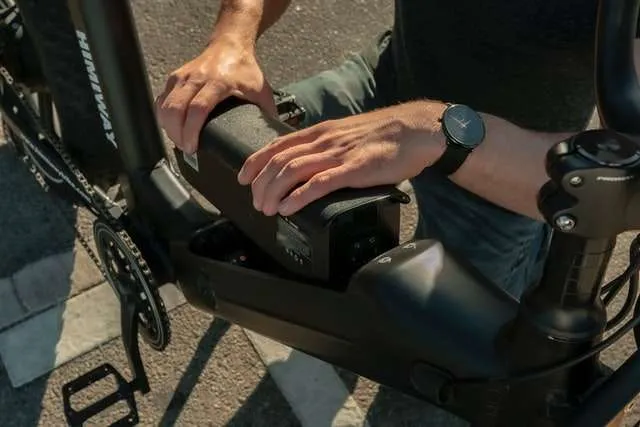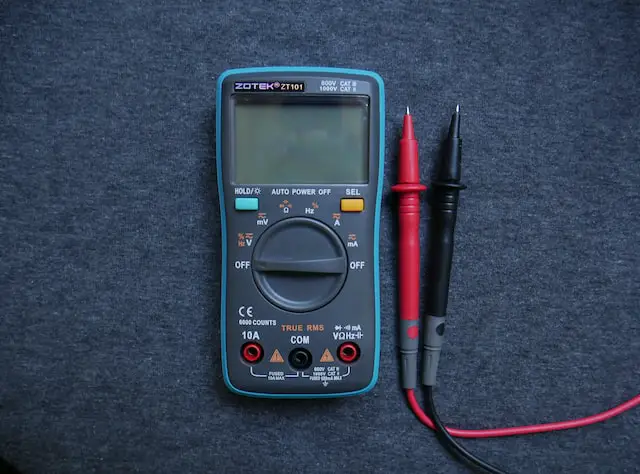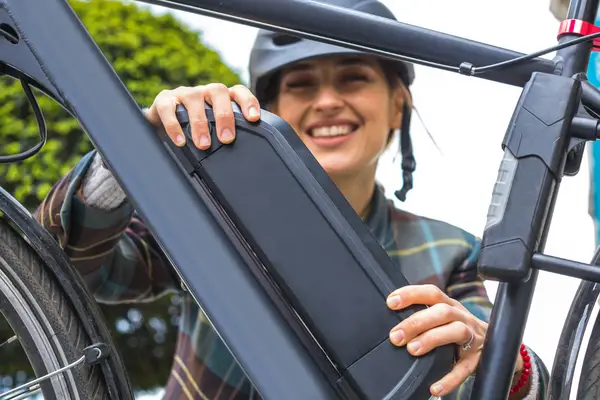You can check your eBike’s battery health using a multimeter or by completing a natural road test. Checking the battery’s voltage, current, and resistance can help you determine if the battery is in good shape.
What You’ll Need
- A multimeter
- A low-traffic road
Ebike Battery Tests

To conduct a thorough Ebike battery test, you must check the battery’s voltage, current, and load and complete a battery load test. It helps to understand each of these terms before you learn how to test your Ebike’s battery.
Voltage
Voltage is the electrical pressure that pushes charged electrons through a conducting loop. Ebikes with a higher voltage move faster than low-voltage Ebikes. Voltage is measured in volts (V). Most electric bikes operate on 36V
Current
Electrical current refers to the stream of charged particles (usually electrons) flowing through an electrical conductor. Electric current is measured in ampere (amps).
Electric currents create the magnetic fields used in electric bike motors. Having higher amps on your eBike requires larger battery backs and thicker gauge wires.
Watts
Watts is basically the rate of power flow in a circuit. The current is the volume of particles flowing and the voltage is like the speed at which they are flowing. Watts = Current x Voltage.
Watt-hours is the measurement unit of the number of watts (power) transmitted by the battery each hour. That is, power consumption. That’s why most electric bills are delivered in watt hours or kilowatt hours. Most Ebikes range between 300 to 1,000 watt-hours.
Resistance
This is simply the resistance to the flow of electricity. A high battery resistance signifies weak electricity flow in the battery.
Battery Load
You can conduct a battery load test to ensure that the interior plate of the battery is in optimum condition.
If the battery wasn’t fully charged before you conducted the test, leave it to charge and then retest to see if anything has changed.
Related post: How to Derestrict an eBike
How To Test Ebike Battery with Multimeter

Multimeters, or multitesters, are among the most common ways to test an Ebike’s battery. These small devices are handheld probes that you can use to measure a battery’s current, voltage, and resistance.
The probe has a screen that displays your readouts. There are two types of multimeters: digital and analog. You should purchase the former because it yields more accurate readings.
Follow these steps to test your Ebike’s battery using a multimeter:
Step 1: Connect the Multimeter to Bike
Connect the multimeter to the bike via a connector or adapter port. Make sure not to apply unnecessary pressure or force the multimeter in. This can damage the Ebike and the probe.
You need to charge your battery fully before commencing this process.
Step 2: Test Load The Battery
Standard multimeters typically have a feature that allows you to test load the battery and an AC/DC readout function. Set the device to DC and avoid using AC because it can strain your bike’s battery too much.
The AC/DC readout doesn’t only test the battery’s ability to turn on. It also determines the energy density needed to communicate with the applications, parts, and motors of the entire Ebike.
Step 3: Test The Voltage
Set the multimeter to the volts function to test your battery’s voltage. The voltage range differs from one Ebike brand to the other, so you need to refer to the bike’s manual for guidance.
If your Ebike’s battery operates below a certain voltage range, the battery will power off. If this happens, you’ll have to recharge the battery. This keeps your bike from getting damaged.

If your bike doesn’t shut off, even if the voltage is around ten or more volts below the accepted range, you might need to check your Bike Monitoring System.
Step 4: Test the Current
You need to test the current to ensure your battery works efficiently. The current is a measure of the number of charges and energy that the battery can hold. It also determines how much energy is released.
Testing the current allows you to keep track of your battery’s longevity. Refer to the average current reading on your bike manual to determine if the battery is in optimal health.
If you notice that your Ebike’s power runs out way too quickly, then there is excess energy expenditure.
Step 5: Test the Resistance
The resistance is the last thing you need to check to ensure that your bike’s battery is working well. Resistance refers to the amount of restriction. This readout is relevant because it directly affects the current.
The resistance is typically the last setting you can find on your multimeter. Check Ebike’s manual for details on the average resistance. If the readout is too high in comparison to the one in the manual, your Ebike might overheat.
Related post: How Long do eBike Motors Last?
How To Test eBike Battery Without Tools
If you can’t get your hands on a multimeter, you can always go back to basics and conduct a real road test. This method requires no tools and can give you an idea of your battery’s range.
Here are some things you need to do to ensure an accurate road test:
Step 1: Fully Charge the Battery

Your test results will be hampered if your bike is not fully charged. Leave your Ebike’s battery to charge overnight to avoid any issues.
Step 2: Check the Initial Capacity of The Battery
Watt-hours = Amps * Battery Voltage is a very easy equation that you can use to calculate your Ebike’s original battery capacity.
You also need to check the battery’s average range. You can find this number, which is a measure of the average watt-hour per mile, on the battery or Ebike controller screen.
When the pedal assist function is activated, the average watt-hour per mile typically ranges from 15 to 20 watt-hours. If you use your bike throttle only, you can expect this readout to rise to 20 to 25 watt-hours.
Step 3: Conduct the Road Test

Take your bike out on the road to start testing its performance. Choose an area that doesn’t have a lot of traffic. This way, you can ensure you don’t waste your battery at stops.
You also need to account for wind and inclinations. If you face a turn while riding, switch the engine off until the turn ends completely. Wait until the road straightens out and there are no inclinations in the road before you switch the engine back on and resume your test. Keep riding until you completely run out of power.
Step 4: Examine the Results
After completing the test, use the following equation to determine the condition of your Ebike’s battery: 100 * the distance traveled / the original capacity (range) of the battery.
For example, 100 = full battery capacity, while 30 = 30% of original capacity
Related post: Can you ride an eBike without battery?
Tips To Maintain Your Ebike Battery
Here are some tips that will help you extend the life of your Ebike’s battery and maintain its health:

Avoid Deep Discharge
Discharging your battery when it’s lower than 20% can hinder its capacity and function in the long run. Lithium batteries can oxidize, which is detrimental to their life and capacity. Always top up your battery once it gets to 30%.
If you aren’t using your Ebike for an extended period, fully charge its battery at least once every three months.
Don’t Expose It to Extreme Temperatures
Extreme heat and frost can hinder your Ebike’s battery life. Don’t park your bike outside where it will be exposed to direct sunlight, heat (over 30ºC), or cold temperatures (below 0ºC).
Don’t Overcharge the Battery Each Time
Avoid charging your battery overnight every time. Wait until your battery is around 25% – 30% before charging. Overcharging the battery can cause the battery to heat up significantly, leading to faster degradation.
Allow The Battery to Cool Down
Avoid charging the battery right after using your Ebike. Charging a heated battery might prevent it from cooling down, which hinders its function.
Suggested: How to ride an electric unicycle
Final Thoughts
If you decide to use a multimeter to check your Ebike’s battery, you need to test the battery, voltage, current, and resistance. Make sure that your bike is fully charged and steadied in place.
Conducting a natural road test is an alternative that requires no tools at all. Fully charge the battery and check its original capacity before you head out on the road.
Avoid deep discharge and extreme temperatures if you wish to maintain your battery’s health. Not overcharging the battery and allowing it to cool down before plugging it in can help you extend your ebike’s battery life.


